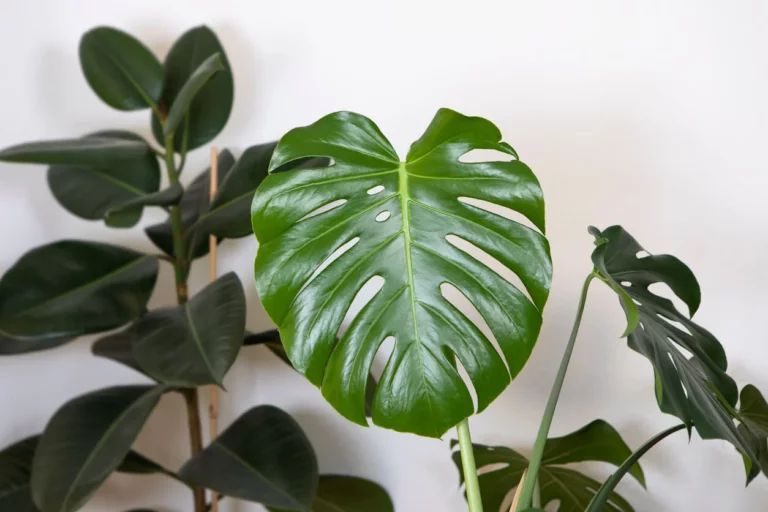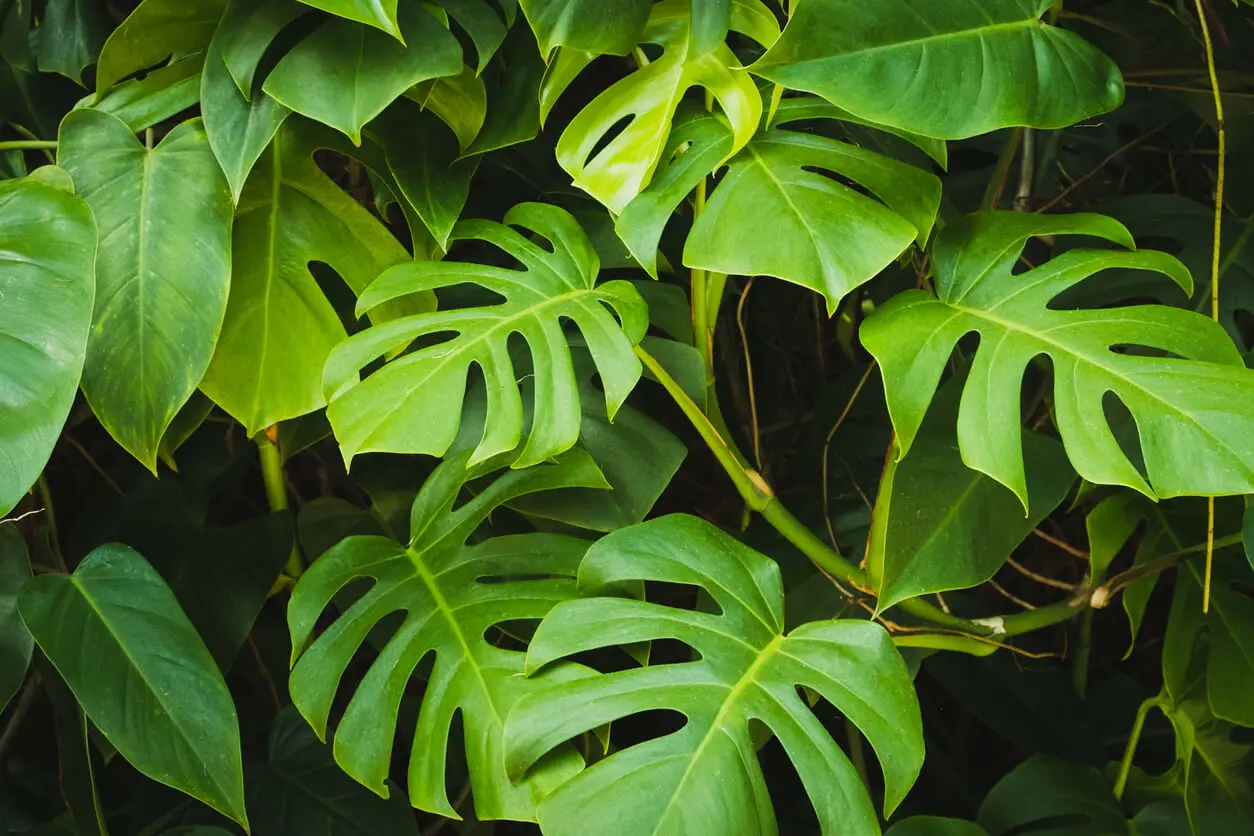6 Tips to Care for a Monstera deliciosa

With large and fascinating leaves, voluminous roots and a captivating flower, this is the Monstera deliciosa. This South American plant is growing in popularity, thanks to the aesthetics it offers and the elementary care it requires. The common thing was to place them in gardens, trying to find a place where the sun does not scorch them, but now the trend is to grow them in pots inside the house.
In the field of professional decoration, the species has gained a place. It is even used as part of television scenery and on magazine covers.
In social networks, videos with a specimen winking in the background also stand out. How to take care of this famous plant and make it grow? We invite you to find out.
Monstera deliciosa: a plant that captivates indoors and outdoors
The tropical aspect of the Monstera deliciosa is a powerful reason to prefer it as an ornamental. The usual thing would be to leave it on the patio, garden or balcony. But you can also keep these large plants indoors.
As a text from the University of Malaga points out, they thrive well in temperatures ranging from 20°C to 30°C, with shade and high humidity. The publication refers to the attractiveness of the leaves, which promotes their use as a decorative element.
In this regard, ID Plantae (digital plant identifier) claims that the species is often chosen to decorate residential and corporate buildings, resorts and hotels, for example. In addition, they are often found in the design of gardens, parks and green areas, occupying borders, flowerbeds or decorating the foot of a tree.
The digital plant identifier highlights that the use of the species in interiors is due to its imposing, ostentation and feeling of freshness.
Facts about Monstera deliciosa
The Virtual Herbarium of the Western Mediterranean details Monstera deliciosa as a perennial, robust plant with large green heart-shaped leaves, which are very divided and show holes.
These leaves also resemble ribs; hence their common name. In popular slang, it is also called ceriman, but its scientific nomenclature is Monstera deliciosa.
It belongs to the Araceae family and it has a flower that looks like a spathe, which blooms between May and October. It is white and barely exceeds 20 centimeters in length.
The plant develops thick roots, even aerial, capable of supporting itself on supports and looking like a vine. Of course, in these cases it is necessary to add a tutor to help it stand upright.
Read How to Grow a Succulent Garden and The Best Plants to Use
Tips for the care and prosperous growth of Monstera deliciosa
Ceriman specimens are not rigid with their care, although it is pertinent to monitor some conditions for their development. In general, they involve quite comfortable attentions for those who carry them out. Here are some tips to help the plant thrive.
1. Water it moderately
Feel the soil to see if it’s moist; if it is, skip watering. If it’s dry, water without puddling.
It is best to use draining pots for this purpose. During the cold seasons, it’s enough to give them water weekly, while in hot seasons or very dry environments, it’s necessary to increase it to a couple of times weekly.
There are those who do not see it pertinent to spray with water the leaves of ceriman; there are also people who defend the practice, considering it a hydration and a method of prevention against the plagues.
2. Try to illuminate it and provide an appropriate temperature
When you leave the plant outside, let it be in a shade or where the sun does not reach it directly. This helps it to sprout flowers after its first 3 years. Monstera deliciosa indoors does not demand much light, but it does not bloom either.
This species withstands lower temperatures, as long as they are not below 0 °C; the cold would burn it. Likewise, placing them next to heat-generating devices will wilt them.
3. Reproduce your Monstera deliciosa via cuttings
The multiplication is by cuttings, taking advantage of the aerial roots. Just cut a stem and place it in a container prepared with a light substrate. Take the seedling to a well-lit room, out of direct sunlight, and water the plantation.
According to InfoAgro magazine, in addition to cuttings, it can be reproduced by seeds. However, they clarify that this is only feasible in tropical climates and implies a more rigorous maintenance and care cost.
4. Prune your Adam’s rib plant frequently
Before pruning the plant it is necessary to sterilize the gardening tools. The cuts must be diagonal and only with scissors.
Pruning is done to control growth, mainly indoors. The procedure is to chop the stem and, to this same one, use it to reproduce a new specimen of Monstera deliciosa.
5. Make sure you give Monstera deliciosa nutrients
Perlite, coconut fiber, and peat are some ideal components for the plant to thrive. The plant likes light, well-drained substrates.
Fertilizer is also essential once a month in spring and summer. In autumn and winter, fertilize only once per season. When you do, don’t forget the irrigation water.
6. Transplant it in the spring
To transplant the ceriman, it is appropriate to wait for the onset of spring. There the temperature and light conditions improve, which favors the photosynthesis of the species to be transplanted.

What can make Monstera deliciosa sick?
Pests are the evil of any plant, and Monstera deliciosa is no different. Although it is a hardy species, aphids and mealybugs can be a problem. In these cases, it is advisable to apply soaps or substances to exterminate the parasites.
A traditional remedy is to wipe it with absorbent cotton soaked in methanol or wood alcohol.
Another possible condition in Monstera deliciosa is discoloration with a tendency to yellow. The transformation is due to too much water and too much exposure to the sun or lack of humidity.
To solve the first cause, just lower the watering frequency, waiting until the substrate is dry enough to hydrate it. Furthermore, you can solve the second by moving the plant to a less sunny area and spraying water on the leaves, with the purpose of increasing humidity.
Read Looking After the Lady of the Night Plant to Enhance Its Scent
Not everything is perfect: pay attention to the toxicity of the species
These plants are eye-catching to the human eye, but they also capture the attention of pets, due to the size of their leaves. If you have dogs or cats at home and they share the same room, it is pertinent to be alert and place the plant in a spot where the animals cannot bite it.
Monstera contains calcium oxalate crystals that stimulate the release of bradykinin and histamine. These substances prick like needles the tongue of the animals that chew it, explains the Veterinary Magazine.
The immediate effects are intense pain in the mouth and oropharyngeal region; also dysphagia, respiratory compromise and glottic edema are possible. Thus, to prevent accidents due to the consumption of this plant, it is advisable to mark a prudent distance between them and the pets.
All cited sources were thoroughly reviewed by our team to ensure their quality, reliability, currency, and validity. The bibliography of this article was considered reliable and of academic or scientific accuracy.
- Herbario Virtual del Mediterráneo Occidental. Monstera deliciosa. Liebm. Herbario Virtual del Mediterráneo Occidental. http://herbarivirtual.uib.es/es/general/1352/especie/monstera-deliciosa-liebm-
- ID Plantae. Monstera deliciosa «costilla de Adán». ID Plantae. https://www.idplantae.com/plantas-ornamentales/monstera-deliciosa-costila-de-adan/
- Infoagro. El cultivo de la Monstera. InfoAgro. https://www.infoagro.com/documentos/el_cultivo_monstera.asp#menuHeaderSectors
- Universidad de Málaga. Monstera deliciosa. Universidad de Málaga. https://jardinbotanico.uma.es/jb-trp-28/
- Zeinsteger, P; Gurni, A. (2004). Plantas tóxicas que afectan el aparato digestivo de caninos y felinos. Revista Veterinaria, 15(1), 35–44. https://revistas.unne.edu.ar/index.php/vet/article/viewFile/2011/1757
This text is provided for informational purposes only and does not replace consultation with a professional. If in doubt, consult your specialist.








